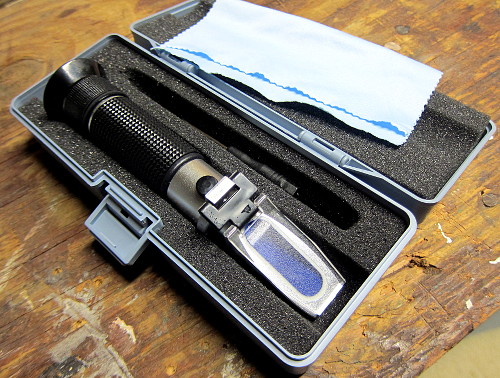Refractometer Crash Course
We’ve got two fermenters to check. But we don’t want to pull a whole hydrometer sample for either of them. What to do? Use a refractometer!

Since a refractometer takes a few drops of sample at a time, it’s trivially easy to measure fermentation progress. But remember, they are calibrated for water not alcohol, so after fermentation starts you need a calculator to get the correct gravity. Also, refractometers typically measure in Brix, a scale normally used for wine. So until you’re comfortable with readings in Brix (or the practically equivalent Plato scale), you’ll want to convert between Brix and Specific Gravity using a different calculator. Yay Internet! So many useful calculators!
A refractometer works by measuring how light changes when is passes through a liquid. Plain water bends light differently than does a solution full of sugar or a solution of sugar and alcohol. By looking at how much that light bends, you can measure how much sugar is in solution. Distilled water should always show a Brix/Plato value of 0 (1.000 SG), while unfermented wort typically starts anywhere from 10 (1.040 SG) to 20 (1.083 SG) depending on the beer.
Since the sample is so small, a refractometer is also extremely useful while fly sparging, to ensure gravity doesn’t fall below the magic 1.010 where tannin extraction might occur. The two or three drops required for the refractometer cool within seconds, as opposed to 5 or 10 minutes for a full hydrometer sample in an un-agitated water bath.
So, fill a bowl with water, add your favorite sanitizer (StarSan or Saniclean), and sterilize your pipette. Be sure to suck some sanitizer into the pipette and squeeze it out too, instead of just sanitizing the outside. Next, open your fermenter and suck up a few samples and squeeze them into a glass. Do this until you have enough for a taste. Then, use the pipette to cover the prism of the refractometer with beer,and flip the sample plate down. Hold the refractometer up to the light, look through it, and note where the color change occurs on the scale. That’s your reading in Brix.
Teh Porter
It’s been two weeks since the porter was brewed, so how’s it doing? Well, airlock bubbles have slowed to about 30 seconds-per-bubble, but as everyone knows that’s not a reliable indicator of anything. But gravity is! So using our trusty refractometer [ed – how trusty can it be already if it’s so new?] we pipette out a sample and measure it: 9 Brix, about 1.019 SG.
Huh, that seems pretty high, since we were expecting around 1.014. There could be a few things going on here; first, the yeast (Wyeast 1968 London ESB) only attenuates 67 – 71%. Second, we may have overshot the mash temperatures a bit, resulting in a less-fermentable wort. Third, the grain bill may simply be less fermentable, and indeed, reviews of the brown malt I purchased from Northern Brewer indicate this: “Be warned, however, that this malt produces a poorly attenuating wort unless you use it in moderation and mash at a slightly low temperature.” Oh well, the sample still tastes great!
Tomorrow I’ll try to rouse the yeast with a large sanitized spoon, but we may be near the end on this one. Last resort: pitch some WLP007 Dry English Ale yeast and hope the alcohol shock doesn’t kill them all.
Teh Cider
In the other corner, the cider is still chugging away. It’s been fermenting for a month, which is pretty common for a cider. Last week I measured 7 Brix (1.014) and this week it’s at 6 Brix (1.006), with bubbles still about 8 seconds apart. The sample has a ton of apple character, but is somewhat thin due to the lack of residual sugar. It seems my strategy of using a low-attenuating/low-alcohol tolerant yeast (WLP002) to retain some sugar just isn’t going to work…
So we’ll sit on this one for a while, at least until the gravity sample stays unchanged for a few days and the airlock activity is slower. Then we bottle!